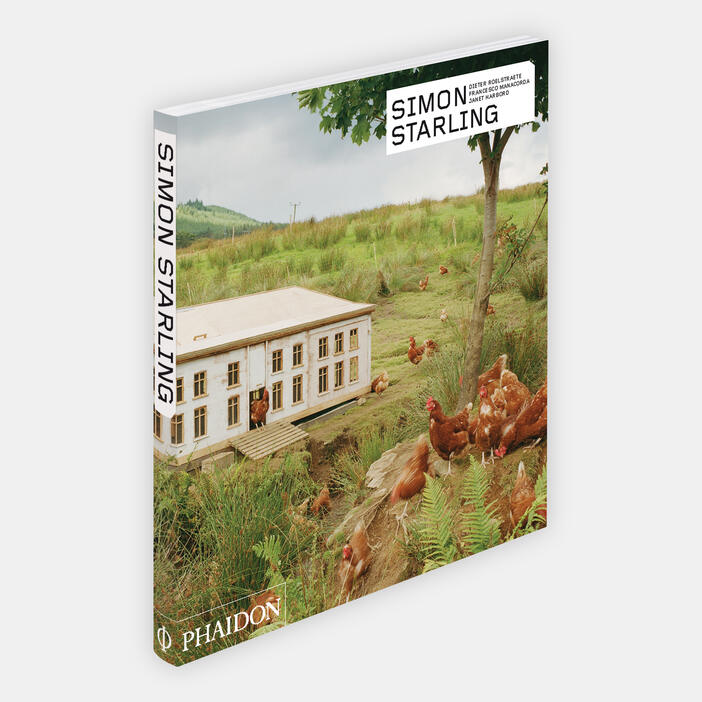

Simon Starling
Price AUD$59.95 Price CAD$49.95 Price £29.95 Price T49.95 Price USD$49.95
Starling's art frequently traffics in deception. It also traffics in traffic, meaning the circulation of goods, knowledge and people (usually the artist himself). Many of his works circle back on themselves, taking an idea on a journey that ends at its point of origin. Wilhelm Noack oHG (2006), for example, is an elaborate helical steel structure designed to loop a thirty-five-millimetre film of the workshop in which it was fabricated. The circuitous path that the film takes through the towering metal structure is the perfect visual metaphor for the work's own circular logic, a self-regulating system that adds up to much more than the sum of its parts.
Starling is a key figure in one of contemporary art's most significant recent developments: the linking of artistic practice and knowledge production. Although this tendency flourished with Conceptual art in the 1960s and 1970s, in recent years it has taken on a new intensity. Unlike the Conceptual artists, however, many of whom strove for a language-based dematerialized art, for Starling the object is always at the work's heart. Economies, ecologies, coincidences and convergences are all simply means to an end - although 'simply' may be the wrong word to describe the transformation of thousands of miles of travel and hundreds of years of history into a single sculpture, film or photograph.
Starling's other predecessors are the Land artists, such as Robert Smithson, with whom he shares a fascination with entropy and other natural forces. But he is truly an artist of the current age, setting out to understand and illustrate the complex processes through which the natural and human-made realms interact. The five platinum/palladium prints that constitute One Ton (2005) show a single view of a South African platinum mine. Together the five prints contain the precise amount of platinum salts that can be derived from one ton of ore, succinctly illustrating the enormous amount of energy required in the extraction of precious metals.
Born in England in 1967 and now living in Denmark, Starling has been the subject of solo exhibitions at museums around the world, including the Hiroshima City Museum of Art (2011), Kunstmuseum Basel (2005) and the Museum of Contemporary Art in Sydney (2002), and his work has been featured in major international group shows, such as the Venice Biennale (2009), the Moscow Biennial (2007) and the São Paulo Biennial (2005). Awards include the Turner Prize (2005), the Blinky Palermo Prize (1999) and the Paul Hamlyn Foundation Award for Artists (1999).
In the Survey, Dieter Roelstraete presents a comprehensive overview of Starling's work, examining circularity and serendipity and the their relationship to historical research. For the Interview, Francesco Manacorda and the artist discuss the central role of time in his work. Janet Harbord's Focus scrutinizes Wilhelm Noack oHG (2006) as an example of material cinema. Artist's Choice is a extract from Flann O'Brien's 1996 novel The Third Policeman, a fantastical conversation about bicycles swapping atoms with their riders. Artists Writings include five project statements, all of which consist, in varying proportions, of history, science and speculative fiction. Specifications:
- Format: Paperback
- Size: 290 × 250 mm (11 3/8 × 9 7/8 in)
- Pages: 160 pp
- Illustrations: 200 illustrations
- ISBN: 9780714864198
Francesco Manacorda is Director of Tate Liverpool. Formerly Curator at the Barbican Gallery in London, where his exhibitions included 'Radical Nature' (2009) and 'Martian Museum of Contemporary Art' (2008), he is also a visiting lecturer at London's Royal College of Art.
Janet Harbord is Professor of Film Studies at Queen Mary, University of London. Her books include Chris Marker: La Jetée (2009), The Evolution of Film: Rethinking Film Studies (2007) and Film Cultures (2002).
On the Contemporary Artists Series
"The boldest, best executed, and most far-reaching publishing project devoted to contemporary art. These books will revolutionize the way contemporary art is presented and written about."—Artforum
"The combination of intelligent analysis, personal insight, useful facts and plentiful pictures is a superb format invaluable for specialists but also interesting for casual readers, it makes these books a must for the library of anyone who cares about contemporary art."—Time Out
"A unique series of informative monographs on individual artists."—The Sunday Times
"Gives the reader the impression of a personal encounter with the artists. Apart from the writing which is lucid and illuminating, it is undoubtedly the wealth of lavish illustrations which makes looking at these books a satisfying entertainment."—The Art Book